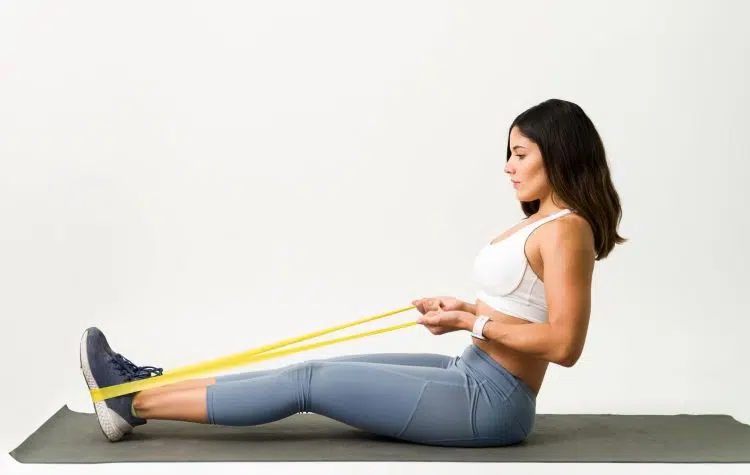Want a cable-worthy back workout without the gym? Explore how resistance band rows mimic cable rows and offer a portable, adaptable option for building muscle and strength anywhere.
As a personal trainer with seven-plus years of hands-on experience, I have worked with numerous clients aiming to build muscle while working out in the comfort of their living rooms. Building muscle at home without dumbbells and barbells is entirely possible; don’t let Instagram or mainstream media tell you otherwise.
A study published in Sage Open Medicine found no significant difference in muscle strength gains between training with resistance bands and conventional weights. It suggests bands can be as effective for strength training and hypertrophy as free weights. (1)
Why You Should Consider Resistance Band Rows (and Ditch the Cable Machine)
I had decided that cable rows would be a staple in my back training routine when I saw Arnold Schwarzenegger perform them in the cult-classic documentary Pumping Iron (1977).
Now that I have spent over 16 years in the trenches, I am slowly realizing that cable machines, other bulky machines, or even a gym membership are not necessary to build a chiseled physique (Arnie would agree, too).
Most people prefer cable machines because they are safer than free weights, deliver constant tension on the target muscles throughout the ROM, and offer a resistance profile that delivers peak muscle contraction in the fully shortened position.
Level Up Your Fitness: Join our 💪 strong community in Fitness Volt Newsletter. Get daily inspiration, expert-backed workouts, nutrition tips, the latest in strength sports, and the support you need to reach your goals. Subscribe for free!
Guess that? Resistance bands offer all the same benefits — and are insanely cheaper than cable machines.
Training equipment like resistance bands offers a portable, affordable, adaptable solution that mirrors the effectiveness of cable machines.
You could virtually perform every cable exercise with a resistance band, making them an excellent option for people who train at home or frequent travelers.
Plus, resistance band exercises are incredibly effective for people recovering from an injury. However, you must consult your healthcare provider before starting a new training or exercise program.
Mimicking Cable Rows with Resistance Bands: How To
The cable rows and resistance bands are very similar in terms of movement patterns and muscle activation. Both exercises target the lats, rhomboids, teres major and minor, rear delts, and biceps.
Cable rows and resistance bands offer a similar resistance profile and require keeping your core engaged throughout the exercise to stabilize the movement.
Resistance Band Rows For Back Development
Since both the exercises are strikingly similar, I will take you over the step-by-step instructions of the resistance band rows.
- Anchor the resistance band to a sturdy object like a heavy coffee table at knee height.
- Sit on the floor facing the table with your legs extended and placed flat on the ground.
- Grab a D-handle in each hand with a neutral grip (palms facing each other).
- Your torso should be upright, and your arms extended and parallel to the floor. The resistance band should be taut in the starting position.
- While keeping your torso upright, pull your hands to your midline while driving through your elbows and keeping them tight to the sides.
- Pause and squeeze your lats in the isometric contraction.
- Slowly return to the starting position.
- Repeat for recommended reps.
Pro Tip: Sit at an appropriate distance from the anchor point so there is tension on the resistance band at the bottom of the range of motion. Feel free to lean forward slightly for a deeper lat stretch.
Common Cable Rows and Resistance Band Row Mistakes
Since cable and resistance band rows are very similar, most people make identical mistakes in both these exercises, leading to suboptimal results and increased injury risk. Here are a few of these errors:
- Rounding the Back: This is by far the most common mistake lifters make while performing this exercise. Leaning forward for a greater lat stretch is permissible, but you shouldn’t hunch your shoulders and round your back as it can remove the tension from the target muscles and transfer it to secondary muscles.
- Using Momentum: Swinging the torso back and forth like a pendulum is one of the first errors I usually have to address while working with my personal training clients. You must limit momentum to load the upper back muscles optimally.
- Flaring Elbows: Spreading the elbows on concentrics leads to greater shoulder recruitment. Keep your upper arms tight to your sides and pause at the top of the ROM for peak target muscle contraction.
- Sticking to the Same Grip: Although I recommend using a neutral grip in this guide, you don’t have to marry it. Switch the hand position routinely to target your back from different angles.
- Going Too Heavy: You might think going too heavy is impossible on the resistance band rows. However, you couldn’t be further from the truth. Folks training for hypertrophy should be able to perform 8-12 reps with the resistance band with a picture-perfect form. Use a lighter band if your form starts to break before this milestone. (2)
Popular Resistance Band Row Variations: Replicating the Gym at Home
Cable rows and resistance band rows are both incredibly effective for building a back that is as wide as a billboard. However, sticking to only these two exercises can get boring and redundant.
Here are some of the best seated row variations that will keep your workouts interesting and challenging:
Bent-Over Resistance Band Row
Stand upright with a shoulder-wide stance on a resistance band. Grab a D-handle in each hand with a neutral grip. Bend your knees slightly and hinge at the hips so your torso is almost parallel to the floor.
Brace your core and row the bands toward your lower abdomen while keeping your elbows close to your body. Hold the isometric contraction for a couple of seconds. Slowly return to the starting position.
- Progression: Banded deadlift
- Regression: Single-arm bent over row
Pro Tip: Take a deep breath and hold it during concentrics. Breathe out slowly on eccentrics. Avoid fully extending the elbows at the bottom to keep constant tension on the target muscles.
Banded Face Pull
Anchor the resistance band around a sturdy object like a door frame at face level. Grab the D-handles with a pronated grip. Take a big step back and assume a staggered stance for added stability.
Your hands should be fully extended and at eye level at the starting position, and the resistance band should be taut. Drive your elbows toward your midline while contracting your posterior deltoids.
- Progression: Banded inverted row
- Regression: Seated resistance band row
Pro Tip: I cue my personal training clients to retract their shoulder blades on concentrics to maximize target muscle stimulation.
Level Up Your Fitness: Join our 💪 strong community in Fitness Volt Newsletter. Get daily inspiration, expert-backed workouts, nutrition tips, the latest in strength sports, and the support you need to reach your goals. Subscribe for free!
Single-Arm Seated Resistance Band Rows
Anchor the band to a sturdy object like a table at knee level. Sit on the floor with your legs extended. Grab one end of the resistance band with an overhand grip.
While keeping your torso upright, pull your hands to your midline and pause in the fully shortened position. Revere the motion to return to the starting position. Lean over slightly for a deeper lat stretch.
- Progression: Seated resistance band row
- Regression: Standing single-arm row
Pro Tip: I’m a big fan of unilateral exercises, as they can help fix muscle and strength imbalances. Externally rotate your wrists during concentrics for maximal target muscle engagement.
Advanced Tips and Techniques For Resistance Band Rows
Mimicking cable rows with a resistance band is great, but why stop at that when you can achieve so much more? Take your back gains to the next level with these pro tips:
- Advanced Training Techniques: Supersets, drop sets, intra-set stretching, and BFR are incredibly effective training methods for muscle and strength gains. Employ them in your home workouts to multiply your results.
- Switch Up the Rep Tempo: I highly recommend slowing down the eccentrics (lowering) phase while performing resistance band rows to maximize the target muscle stimulation.
- Uneven Band Length: This is something I use with my advanced personal training clients. Asymmetrical load challenges your core stability and balance, which could improve your functional strength.
- Combine with Other Exercises: You don’t have to limit yourself to vanilla resistance band exercises. Add a resistance band to exercises like bent-over barbell rows to tweak its resistance profile and challenge your muscles further.
The Portable and Adaptable Resistance Band Workout
Let’s face it: life can be hectic. Many can’t find the time between managing work, family, and other commitments to hit the gym.
However, resistance bands can come in handy and help you achieve your fitness goals.
Contrary to what most people think, you don’t need elaborate training regimens that require two to three hours daily to carve the physique of your dreams. You can get in the best shape of your life with 20-45 minutes of targeted training.
Below, I’ll give you a full-body resistance band circuit workout that you can complete within 30 minutes:
Warm-Up (5 minutes)
Pick between dynamic stretches, light cardio, or bodyweight exercises to loosen your muscles and get the blood flowing into the target muscles. Some of my favorites include jumping jacks, jumping rope, or jogging in place.
Circuit (3 sets of 10-12 reps per exercise with 30-second rest between exercises):
- Squats with a resistance band around the thighs
- Lunges with a band looped under feet
- Chest press with band held behind back
- Seated rows with one end of a band wrapped around a pole
- Overhead press with a band looped under feet
- Resistance band crunches with one end of the band anchored to a high surface
- Anti-rotational press with band held at chest level
Cool-down (5 minutes)
Perform static stretches and hold each stretch for 20-30 seconds. I also recommend that my clients perform self-myofascial massage using a foam roller to flush the lactic acid out of the muscles and begin the recovery process.
Benefits of Using Resistance Bands For Rows Over Cables
These are some of the advantages of adding a resistance band to your exercise arsenal:
Compact
The form factor of the resistance band allows you to use it anywhere at any time, whether you are training in your living room or are waiting for your connecting flight at an airport.
This lightweight training equipment can fit easily into a gym bag, backpack, suitcase, or even your pocket.
Once you buy a resistance band, skipping a workout because you don’t have the time to hit the gym is no longer a viable excuse.
Adaptability
Whether you are a beginner or an experienced lifter, you can find a resistance band that suits your training needs.
Newbies can start with the lightest band, whereas serious lifters can stack multiple bands to add resistance.
Also, beginners can perform the exercises with a limited range of motion, while veteran exercisers can perform a higher number of sets and reps or use slow rep tempos to increase the time under tension and promote hypertrophy. (3)
Versatility
Resistance bands are among the most versatile training equipment you can get your hands on. Besides the rows, you can mimic most of the cable (and even free weight) exercises using a resistance band.
Your imagination is the only thing holding you back while using a resistance band. I have my experienced bodybuilding clients perform resistance band exercises as a superset to amplify muscle pumps.
A study published in the Journal of Strength and Conditioning Research observed a positive correlation between immediate muscle swelling (pump) and long-term hypertrophy after six weeks of resistance training. (4)
Looking for the best resistance bands to supercharge your training regimen? Here are the top resistance bands for different goals.
Conclusion
Cable rows vs. resistance band rows — so which should you choose?
The truth is, both exercises are incredibly effective and deserve a place in your training regimen. People who train at home can use the advanced training techniques and variations listed in this article to spice up their workout program.
If you have any questions about how to mimic cable rows using a resistance band, drop them in the comments below, and I’ll be glad to help!
References
- Lopes JSS, Machado AF, Micheletti JK, de Almeida AC, Cavina AP, Pastre CM. Effects of training with elastic resistance versus conventional resistance on muscular strength: A systematic review and meta-analysis [published correction appears in SAGE Open Med. 2020 Sep 9;8:2050312120961220]. SAGE Open Med. 2019;7:2050312119831116. Published 2019 Feb 19. doi:10.1177/2050312119831116
- Schoenfeld BJ, Grgic J, Van Every DW, Plotkin DL. Loading Recommendations for Muscle Strength, Hypertrophy, and Local Endurance: A Re-Examination of the Repetition Continuum. Sports (Basel). 2021;9(2):32. Published 2021 Feb 22. doi:10.3390/sports9020032
- Burd, N. A., Andrews, R. J., West, D. W., Little, J. P., Cochran, A. J., Hector, A. J., Cashaback, J. G., Gibala, M. J., Potvin, J. R., Baker, S. K., & Phillips, S. M. (2012). Muscle time under tension during resistance exercise stimulates differential muscle protein sub-fractional synthetic responses in men. The Journal of physiology, 590(2), 351–362. https://doi.org/10.1113/jphysiol.2011.221200
- Hirono, T., Ikezoe, T., Taniguchi, M., Tanaka, H., Saeki, J., Yagi, M., Umehara, J., & Ichihashi, N. (2022). Relationship Between Muscle Swelling and Hypertrophy Induced by Resistance Training. Journal of strength and conditioning research, 36(2), 359–364. https://doi.org/10.1519/JSC.0000000000003478









